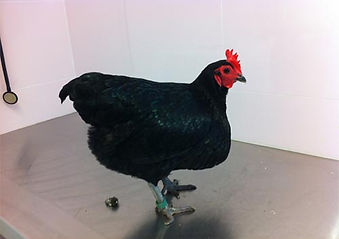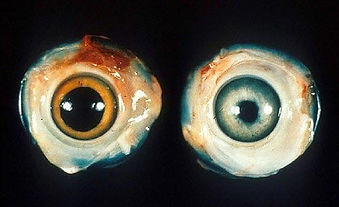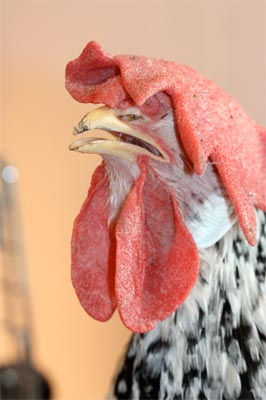
POULTRY
Marek's Disease
By Dr Rob Marshall
This article discusses the impact of Marek’s Disease on the overall health of Show or Backyard Chickens and describes the symptoms, many different forms of the disease and the control measures that can be taken to manage the disease. An breeding strategy that develops genetic resistance against Mareks Disease and management that controls stress in young chickens (refer to the article “Raising Chickens from Eggs” in this section) obviates any need to vaccinate against this significant disease.
Introduction
I consider Marek’s Disease to be the most significant and most under-diagnosed disease of show and backyard poultry. It is often the underlying cause of many other diseases and problems.
Firstly we must recognize the great difference between pure-bred show poultry and commercial breeds of chickens and understand that we manage them quite differently in regards to virus infections where often vaccinations are neither cost effective or necessary.
As chicken breeders we have the opportunity to develop families of show chickens that not only look good but are able to stay healthy as a result of strong genes. Unfortunately commercial breeds have been bred solely for production purposes but at the expense of a strong natural immunity so that they are more susceptible to virus disease compared to show poultry that have been bred with a strong natural resistance against these diseases. It is this genetic resistance - that must be preserved in our show chickens – which has resulted from selecting male birds with exceptional vigour and from a breeding background of many generations that have been resistant to these diseases.
For show poultry the large majority of diseases associated with viruses and other infections occur in young birds - either as very young chicks (1-7 days of age) - at the start of the juvenile moult around 12 weeks of age - or towards the end of it shortly before reaching sexual maturity at about 6 months of age - although this age varies amongst the different pure bred chicken breeds you may keep.
Viruses stimulate the development of immunity better than do other types of microorganisms so that virus diseases are seldom a problem of mature chickens that have often already been exposed to infection as immature birds and have had ample time to developed immunity against them. Many viral infections go unnoticed as most high quality show chickens are usually very well cared for and they quickly repel these infections with few obvious symptoms appearing.
However, some infected birds may not fully recover and harbour infection becoming what is known as “carrier birds”. These birds do not show any outward sign of diseases but carry the infection in a latent form - and under stress fall ill - at this time they become highly contagious to other birds and contaminate the environment with virus germs. It is this invisible carrier bird that is responsible for the spread of both Marek’s Disease and ILT infections once these diseases enter your premises and why it is so difficult to prevent reinfection of new batches of chicks.
My talk today addresses the options open to you for preventing Marek’s and other virus diseases, as you now understand from what I have just stated that virus diseases are largely a problem of immature birds and will persist in your premises once they have entered your flock.
Symptoms Of Marek's Disease
I would like now to describe the symptoms associated with each of these diseases - firstly Mareks disease then ILT - so that you are aware of what they look like, as it is very important to know whether these diseases are present in your flock before deciding upon a prevention programmed.
Later on I would also like to mention how to differentiate these two diseases from other similar appearing respiratory and non-respiratory viral diseases.

Although clinical signs associated with MD can occur in chickens from 4 weeks of age, signs are most frequently seen between 12 and 24 weeks of age and sometimes later. Paralysis of legs, wings or neck are the obvious symptoms that alerts us to a chicken with Marek’s Disease.
Marek’s disease is a type of cancer that produces tumors in nerves causing the symptoms seen in this photo (left). This is a typical picture and most common form of Marek’s disease seen in show poultry - one leg stretches forward and the other backwards.
Most of the affected birds will have some degree of lameness or paralysis, although chickens with the acute form may not show this condition. The symptoms of lameness and leg weakness without outstretching of the legs may appear with Mareks Disease after the onset of egg laying age and be confused with egg binding. Often this type of lameness is mistaken for an Ecoli or Salmonella-type joint infection, however there is no swelling or hot joints with Marek’s Disease. – This type of paralysis often occurs late Autumn or early Spring following a cold spell.
This form of the disease will cause clinical symptoms and eventual death of 10-15% of birds between 12-16 weeks of age but rarely above this level. The most common clinical sign is partial or complete paralysis of the legs and wings. The signs can vary from bird to bird depending on the involvement of the different nerves. When the nerves controlling the neck muscles are affected, signs such as bending of the head or torticollis are seen.
Birds with paralysis will always die often because they are unable to reach feed and water. It is helpful to perform post mortem examination on dead birds to confirm the diagnosis of Mareks disease. Here you should notice nerve enlargement, especially of the ischiatic nerve passing near the kidneys.
Marek’s Disease also causes increased susceptibility (immunosuppression) to other diseases, so that an excessive number of sickly pullets must also beassumed to have Marek’s Disease until proven otherwise as this virus mostly affects immature females rather than male birds. Look for pullets with signs of weakness, pale combs and wattles, not eating, diarrhea and generally poor doers as signals for Marek’s Disease. Prevention of environmental stress factors from a very young age is important for preventing Marek's Disease (refer to the article “Raising Chickens from Eggs” in this section for details of this method).


Similarly, the involvement of the vagus nerve can result in the paralysis and dilation of the crop seen in this photo (right). Crop impactions and pendulous crops that are quite often seen in Show chickens are often attributed to Marek’s disease as the virus infiltrates the nerves of this region. Crop impaction may also be unrelated to Marek's Diseases when chickens of any age but mostly mature hens over-engorge on grass or other fibrous matter. The fibre in grasses accumulates in a entangled mass that prevents the crop from emptying properly causing it to distend and become impacted (see the "Crop and Gizzard Impactions" article in this section).
Marek's Disease may also look like a respiratory disease as seen in this gaping bird (left). Some birds may gasp and show respiratory distress that makes us think we are looking at a respiratory disease such as Aspergillosis, ILT, Infectious bronchitis or even the wet form of Fowl Pox.
Any immature bird with vision impairment (i.e. birds having trouble picking up food), irregular pupils (one large and one small) or discolored iris (i.e. strange colour changes, blue or grey) should be assumed to be Marek’s Diseases until proven otherwise.



Any raised skin blemishes around the feather follicles - called skin leukosis – should also be assumed to be Marek's Disease until proven otherwise.
Other Forms of Marek's Disease
Although the initial infection occurs at a very young age the first indication of infection is a variation in the growth rate and degree of feathering in birds between 12-24 weeks of age. Some chickens die without any clinical signs of Marek's disease.
Symptoms
-
Acute Form
- 4-8 weeks of age
- 80% Mortality
-
Transient Form
- 5-18 weeks of age
- Uncommon
-
Internal Organ Form
- 16 - 35 weeks of age
- Chronic Illness
Marek’s Disease may occur as an acute outbreak mainly affecting four to eight weeks old chickens. This type of infection often occurs as an epidemic in a previously uninfected or unvaccinated flock and causes depression, paralysis, and death in a large number of birds – with up to 80 percent mortality. With this form of the disease non-specific symptoms such as depression, weight loss, anorexia and diarrhea are seen making it difficult to diagnose without pathology testing.
Transient paralysis - this is a rather uncommon type that occurs between 5 and 18 weeks of age. Affected birds suddenly develop varying degrees of ataxia, paresis or paralysis of the legs, wings and neck. The disease is commonly observed 8-12 days after infection, usually lasts only for about 24-48 hours and is associated with oedema of the brain. In some cases the transient paralysis can be fatal.
The internal organ or visceral form usually occurs in chickens between 16-35 weeks of age. Most birds with this form of Mareks Disese will show some degree of leg paralysis. Weakness, a pale coloured comb and wattle, a disinterest in eating, diarrhoea, reduction in egg laying, sudden death from heart failure (arteriosclerosis) and blindness are other signs of MD that often accompany the paralysis. It is always best to perform a postmortem ofthese birds as you will find obvious symptoms when Mareks Disease is present - notably fleshy cancerous nodules of the ovary, spleen, liver, kidneys, lungs, heart, proventriculus or adrenals.
Marek's Disease Control
-
Genetic Resistance = best cure
-
Stress Control = next best control measure
-
Vaccination = may be needed in some flocks
There are no anti-viral medicines available to treat Marek's Disease so we must look to understanding the nature of the disease itself in order to develop a cure.
The first step to managing this disease is to identify whether the virus is present in your family of birds as some families are resistant to the disease - as the best way to prevent Marek's Disease is to develop a family of birds that is naturally resistant against the virus. Acquire families of birds and use sires that are resistant to MD, because there is strong level of heritability for genetic resistance against MD.
Alternatively, following an outbreak use strong male survivors as these birds have shown a resistance to MD. Developing a family of birds that is genetically resistant to Marek's Disease is by far the best way to cure the disease – but remember stress management measures are also a must!
Stress factors especially social stress is known to precipitate Marek's Disease. Social stress is any form of anxiety produced by overcrowding, poor sanitation, improper housing, other illnesses like worms, coccidiosis, lice and mites - or mixing older birds with young birds - that prevent the young birds from resting eating or drinking – basically preventing them for being happy. Stress management is the best way to control Marek's Disease in flocks that have previously experience Marek's diseases from time to time.
Genetic factors and age of initial exposure to the virus are important determinants of MD susceptibility. It causes most problems in pullet flocks under 16 weeks of age and cockerels are more resistant to Marek’s Disease. Symptoms of Marek’s Disease may also be seen in pullets near or soon afterthe onset of egg production at 5-6 months of age or older depending on breed of chicken.
Because there are no antiviral drugs to cure the disease there are two options open to you for preventing this disease – vaccination or to breed yourself a resistant family of chickens – whatever option you take good management practices must be followed to reduce stress, as ultimately Marek’s Disease is stress induced.
Vaccination is good option for flocks or families who have experienced moderate to high levels of Marek's Disease (MD) – or even in flocks that experience poor health for reasons that remain unclear as often in these flocks Marek's disease is the underlying cause of the problems as the virus prevents the immune system from responding to disease challenges so that coccidiosis and E. coli infections as well as respiratory infections become more common and often there is a poor response of these diseases to treatment and they tend to recur.
Vaccination is given at one day of age because Marek’s Disease has a short incubation period of 2 weeks with signs of disease appearing in birds as young as 3 weeks of age – even though the disease is not spread through the egg and newborn chicks are protected by maternal antibodies for a few weeks.
The aim of vaccination is to prevent the virus from accumulating in the environment of the young chickens, as Marek's Disease is highly contagious being spread through dander form feather follicles (feather dust) and transmitted by inhalation.
Vaccination is the only means for controlling Marek's Disease in infected flocks because there are no treatments that cure an infected bird.
Chinese Silkies are our first choice backyard chicken. They are robust, loveable, quiet, lay good quality eggs and make ideal pets.
Our programmes are a simple and effective way to provide your chicken companions with the best possible care.
Click for information regarding our holistic methods for managing chicken diseases.





